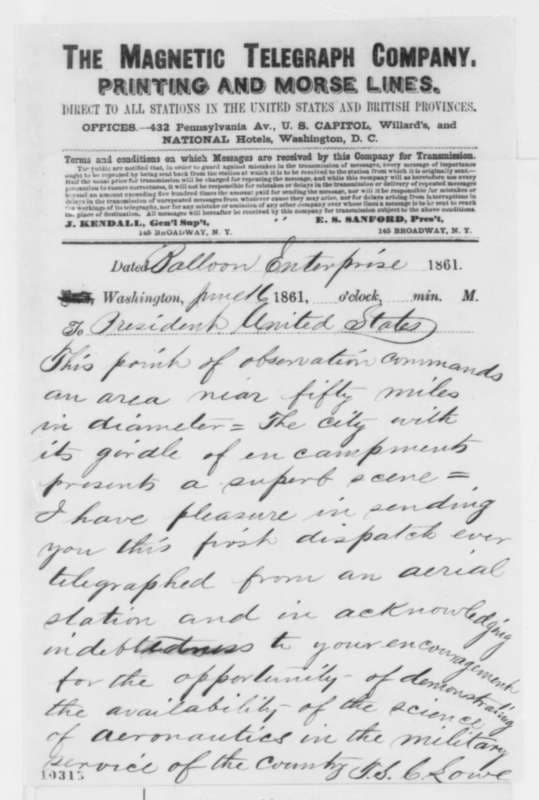The Gas Balloon Pilots of the American Civil War
We all heard about the Chinese spy balloon last year, but did you know that during the Civil War, the U.S. had its own sky-high spies? President Lincoln commissioned the first American air force—the Balloon Corps—led by the daring Thaddeus Lowe.

The Birth of the American Air Core
World War I is typically considered the first war where the United States deployed aviation forces, but in actuality, the U.S. military began to rely on military aircraft over fifty years before WWI, during the Civil War. Both the Union and the Confederacy used hot air balloons for reconnaissance to help determine the location of troops and artillery. This innovation in aerial warfare was a trailblazer for its time, as it took place forty-two years before the invention of the airplane.
Thaddeus Lowe: The Father of Military Aviation
Thaddeus Sobieski Constantine Lowe, an accomplished aeronaut and inventor, was the man behind this innovative military strategy. Lowe’s passion for ballooning and his belief in its military applications led him to demonstrate the utility of balloons to President Lincoln. On June 17, 1861, Lowe made a historic flight from the lawn of the nation’s capital, reaching an altitude of 500 feet and sending a telegram to Lincoln from the sky, showcasing the potential for aerial reconnaissance.


The Balloon Corps in Action
The Balloon Corps, officially established in 1861, was a small but highly effective unit. It consisted of a handful of balloons, pilots, and support personnel. The primary mission was to gather intelligence on Confederate troop movements and positions, providing crucial information to Union commanders.
Lowe and his team operated a fleet of gas balloons, including notable ones like the Intrepid, Constitution, and Union. These balloons were tethered to the ground with long cables and ascended to heights that provided a bird’s-eye view of the battlefield. From their elevated vantage points, the balloonists could observe enemy activities and relay information to the ground via telegraph or signal flags.

The First Aircraft Carrier
In an extraordinary feat, the balloonists also became the first to create an aircraft carrier by launching a hydrogen gas balloon from a barge on the Potomac River. This innovative approach allowed them to deploy their balloons closer to the front lines, providing even more timely and accurate intelligence.
Courage and Innovation
The balloon pilots of the Civil War faced numerous challenges. They operated in dangerous conditions, often under enemy fire. The balloons were vulnerable to weather, and the hydrogen gas used for inflation was highly flammable. Despite these risks, the Balloon Corps provided invaluable intelligence that contributed to several key Union victories.
One of the most notable instances of the Balloon Corps’ impact was during the Peninsula Campaign in 1862. Lowe’s aerial observations allowed Union General George B. McClellan to make informed strategic decisions, significantly influencing the course of the campaign.
Legacy of the First Air Core Veterans
Although the Balloon Corps was disbanded in 1863 due to logistical and funding issues, its legacy lived on. The bravery and ingenuity of these early airmen laid the groundwork for future developments in military aviation. Their pioneering efforts demonstrated the potential of aerial reconnaissance, a concept that would evolve into the sophisticated air forces of the 20th century and beyond.

Remembering Their Sacrifice
As we commemorate Memorial Day, it is fitting to remember and honor the first air core veterans—the gas balloon pilots who soared above the battlefields of the Civil War. Their courage, innovation, and dedication to duty were instrumental in shaping the future of military aviation. They were true pioneers, and their contributions deserve recognition alongside the many other heroes who have served our nation.
Let us take a moment to reflect on the remarkable history of these early aviators and the enduring legacy they left behind. Their story is a testament to the spirit of innovation and bravery that has always defined the United States Armed Forces.
On this Memorial Day, as we honor all those who have served and sacrificed, let us not forget the gas balloon pilots of the American Civil War. These first air core veterans were visionaries who saw the future of warfare from above and helped pave the way for the modern air forces we rely on today. Their legacy is a proud chapter in the history of American military aviation, and their contributions continue to inspire us to reach for the skies.
